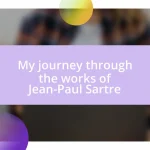Key takeaways:
- Toni Morrison’s narratives profoundly explore themes of Black identity, history, and womanhood, inviting readers to confront uncomfortable truths about love, memory, and trauma.
- Key themes in her works include identity and self-discovery, motherhood and family dynamics, historical memory, and the duality of love and trauma.
- Morrison’s characters, such as Sethe and Milkman, reflect real-life struggles, illustrating the intricate relationship between personal growth and historical legacy.
- The significance of storytelling and communal healing is emphasized, as characters reclaim their narratives and find strength in shared experiences.

Introduction to Toni Morrison
Toni Morrison stands as a monumental figure in American literature, celebrated for her profound exploration of Black identity, history, and womanhood. I remember the first time I picked up “Beloved”; I was struck not just by the haunting narrative but by the way Morrison’s prose resonated with emotional depth, almost lifting the burden of untold stories right off the page. How does one author encapsulate the richness and pain of a collective experience so vividly?
Morrison’s unparalleled ability to weave intricate characters and narratives makes her works not just stories, but essential reflections on society. Each of her novels feels like a journey into the complexities of human emotions and relationships. I often found myself lost in her world, empathizing with characters like Sethe and Pecola, as they navigated their struggles against the backdrop of systemic oppression. Have you ever felt such a connection to a book that it lingered in your mind long after you turned the last page?
Through her powerful storytelling, Morrison invites readers to confront uncomfortable truths and contemplate the intricacies of love, memory, and trauma. I recall a poignant passage from “Song of Solomon” that made me stop and reflect on my own family history; it was as if Morrison was urging me to dig deeper into my roots and embrace the complexities of my own identity. Her narratives compel us not only to listen but to understand the stories that shape our past and present.

Understanding Key Themes
Understanding the key themes in Toni Morrison’s work is like peeling back layers of a complex, emotional onion. Each theme resonates with deep historical significance, revealing the struggles and triumphs of Black lives in America. I vividly remember discussing “The Bluest Eye” in a reading group; we couldn’t help but feel the weight of cultural beauty standards and their impact on self-worth, a conversation that sparked genuine reflection among us.
Key themes in Morrison’s narratives include:
– Identity and Self-Discovery: Characters often grapple with their sense of self amid societal expectations.
– Motherhood and Family: Morrison poignantly explores the complexities and burdens of maternal relationships.
– Historical Memory: Her narratives emphasize the importance of remembering the past and acknowledging its influence on the present.
– Love and Trauma: The intersection of love and pain often drives her characters’ journeys, showcasing the duality of human experience.
– Community and Isolation: The pull between belonging and alienation is a recurring motif, depicting the tight-knit yet often suffocating nature of communities.
As I delved further into “Sula,” I found myself contemplating friendships and betrayal through a new lens. The way Morrison portrayed the lives of two women navigating their inseparable bond yet distinct paths made me reassess my own relationships. It’s remarkable how her themes can spark such personal reflections, inviting us to reevaluate our experiences and beliefs.

Exploring Character Development
Morrison’s characters are often multidimensional, layered with complexities that mirror real-life struggles. I recall reading “God Help the Child,” where the protagonist, Bride, grapples with childhood trauma and societal expectations of beauty. It struck me how her journey of self-acceptance felt relatable, illuminating the darkness of her past while shedding light on her path forward. Have you ever seen a part of yourself reflected in a character’s struggle? It’s a powerful experience.
In “Song of Solomon,” Milkman Dead’s transformation unfolds remarkably as he seeks his ancestral roots. This quest, rooted in self-discovery, resonated deeply with me. I remember reflecting on my own family history while reading, thinking about how our past influences our present and shapes our identity. Morrison’s characters, like Milkman, embody the intricate dance between personal growth and the entwined legacy of history.
The depth of Morrison’s character development often leaves a lasting impression. She not only crafts their stories but also invites readers to inhabit their world. For instance, Pecola in “The Bluest Eye” elicits a sense of urgency to address internalized racism and the pursuit of beauty that feels unattainable. It made me question the narratives we accept about ourselves and others. How often do we overlook the nuances of someone’s story? Morrison urges us to listen and, in turn, helps us to understand one another on a more profound level.
| Character | Development Theme |
|---|---|
| Sethe (Beloved) | Struggle with the past and trauma |
| Pecola (The Bluest Eye) | Internalized racism and self-worth |
| Milkman (Song of Solomon) | Quest for identity and ancestral roots |
| Bride (God Help the Child) | Journey of self-acceptance |

Analyzing Narrative Techniques
Morrison’s narrative techniques are a captivating blend of lyrical prose and rich symbolism. One technique that stands out to me is her use of non-linear storytelling. For example, in “Beloved,” the story unfolds in fragments, mirroring the fragmented experiences of the characters. This approach creates an immersive experience; I often found myself piecing together the emotional puzzle of Sethe’s past, feeling as though I was unearthing buried memories alongside her.
Another powerful element is Morrison’s incorporation of magical realism. I remember reading “Song of Solomon” and being struck by how the ordinary often intertwines with the extraordinary. The idea of flying, as presented through Milkman’s heritage, symbolizes freedom and escape—something I think we often yearn for in our own lives. Have you ever felt the urge to transcend your circumstances? Morrison’s work invites us to reflect on our desires for liberation while simultaneously illuminating the barriers we face.
Additionally, her distinctive dialogue richly captures the cultural vernacular of her characters. In “Sula,” I was enthralled by how conversations revealed not only personal dynamics but also the weight of communal history. The interplay of voices creates a rhythmic quality that resonates deeply. It made me consider how language shapes our identities. When was the last time you felt the power of your own words? Morrison masterfully shows us that our narratives, spoken and unspoken, are vital components of who we are.

Impact of Historical Context
Morrison’s narratives cannot be fully appreciated without understanding the historical backdrop against which she wrote. The painful legacy of slavery and systemic racism looms large in her works, shaping the identities of her characters. I remember feeling a profound ache as I read “Beloved,” where the haunting memories of slavery not only impact Sethe’s life but also resonate with the broader African American experience. How can one escape the shadows of such trauma? It’s a question that lingers in my mind.
The societal expectations and challenges faced by Black individuals during Morrison’s time are intricately woven into her stories. For example, in “The Bluest Eye,” the tragic pursuit of an unattainable standard of beauty reflects the pervasive racism that still echoes today. This cruel reality made me reflect on my own experiences with societal pressures, as I realized that the impact of historical context extends beyond the page. Have you ever found yourself conforming to societal norms, pushing aside your authentic self? Morrison’s exploration of these themes compels us to confront our own identities.
Moreover, Morrison often highlights the resilience of her characters, which can be seen against the backdrop of these historical struggles. Characters like Milkman Dead, in “Song of Solomon,” not only seek personal identity but also reclaim their heritage amidst the weight of history. I felt invigorated by Milkman’s journey, as it reinforced the idea that acknowledging our roots can empower us to forge our own paths. How often do we overlook the strength that history lends to our own narratives? Through her deft storytelling, Morrison teaches us that understanding our past can illuminate our present and guide our future.

Personal Reflections on the Journey
Reflecting on my journey through Toni Morrison’s narratives, I often find myself wrestling with my own identity. One moment that stands out vividly is when I first encountered “The Bluest Eye” during a period of self-discovery. It was eye-opening to see how Pecola’s struggles mirrored the insecurities I faced growing up. I remember asking myself, what beauty standards have been imposed on me, and how has that shaped my self-worth? Morrison’s raw portrayal of this theme challenged me to reevaluate the lenses through which I viewed myself.
Another profound reflection came from reading “Beloved.” The haunting nature of the story resonated with me deeply, evoking feelings of empathy and sorrow. There was one scene that made my heart ache—when Sethe confronts the repercussions of her past decisions. I found myself questioning how traumas can linger in our minds and affect our relationships. Have you ever felt the weight of your own past on your shoulders? For me, it was a gentle reminder that healing is a journey, often intertwined with the stories we carry.
Morrison’s work evokes a sense of community that invites readers like me to explore our heritage. I recall engaging in discussions with friends about “Song of Solomon,” where we shared our personal interpretations of flight and freedom. These conversations revealed how interconnected our narratives can be. It made me realize that while our journeys are unique, they’re often shaped by our shared histories and cultural experiences. How can we use those connections to uplift one another? Through Morrison’s lens, I learned that embracing our collective narratives offers strength and a sense of belonging that transcends individual struggle.

Lessons Learned from Morrison’s Works
Morrison’s works have taught me the importance of storytelling as a form of resistance. In “A Mercy,” I was struck by the story of Florens, a young girl who navigates her identity in a world that often erases her. Her journey illuminated the power of reclaiming one’s narrative amidst oppression. I began to ponder—how often do we let others define our stories? This urge to take control of our narratives is a crucial lesson drawn from Morrison’s exploration of fragmented identities.
Another significant insight I’ve gained from Morrison’s writing is the concept of healing through community. In “Paradise,” the interconnected lives of the women in the convent illustrate the strength found in sisterhood and shared experiences. It reminded me of the times I’ve leaned on close friends during difficult periods, creating spaces where vulnerability is welcomed. Can we truly heal alone? Morrison seems to suggest that healing is often collective, encouraging me to foster connections that support emotional wellbeing.
Furthermore, the theme of memory in Morrison’s narratives resonates deeply with me. In “Beloved,” the haunting vision of the past serves as a constant reminder of how we are shaped by our histories. I recall moments when memories flooded back unexpectedly, revealing layers of my own identity. It made me reflect: how do we honor our past while moving forward? Engaging with Morrison’s portrayal of memory helped me understand that embracing our histories is essential for personal growth, teaching me to acknowledge both the pain and beauty in my own journey.













